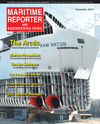
Page 55: of Maritime Reporter Magazine (September 2014)
Marine Propulsion Edition
Read this page in Pdf, Flash or Html5 edition of September 2014 Maritime Reporter Magazine
www.marinelink.com 55 to compare against electronic manifests and historical records. This data can be used as an operational aid to screeners minimizing false positives and nega- tives.
Throughout the process of offl oad- ing and inspection, a logistics program assigns the container to a location in a stack on the domestic section of the port.
Freight in this section is staged for trans- shipment onto smaller ships that opti- mize transit to a domestic port for the most effi cient delivery possible.
This trans-shipment port has ad- vantages beyond security. Given the importance of protecting our coastal population centers from a WMD attack, providing for more secure borders from human traffi cking and smuggling, and maintaining the resiliency of our critical infrastructure is important, we also want to see where the economic benefi ts come from.
These offshore ports can couple the most effi cient way to move goods inter- nationally (ultra-large containerships), and the most effi cient way to move goods domestically (short-sea shipping), with an effi cient port that can offl oad eight 18,000 TEU ships simultaneously in 36 hours. The process can move the sorting of freight that now occurs after cargo enters domestic ports, to offshore.
This allows freight to be “packaged” for delivery to domestic ports nearer to fi nal destinations or to areas with effi cient in- termodal connectivity through a hub and spoke distribution system.
Faster turn-around time for the larger ships allows more trips per year and more time at sea, increasing profi ts for ship owners. The faster processing of freight, hub and spoke distribution, and concurrent customs inspection allows for the faster delivery of freight. An economy of scale is achieved when new technologies are developed. Implemen- tation and investment occurs at relatively few offshore ports instead of signifi cant investments duplicated at all major ports in the U.S.
Technology development of offshore platforms provides economic growth and capabilities in vital industries, such as shipbuilding, alternative energy, de- salinization, aquaculture, and LNG ex- ports. Offshore platforms also facilitate access to remote areas like the Bering and Beaufort Seas, which opens up pos- sibilities for artic shipping routes and port expansion.
Domestic job creation is achieved by strengthening our merchant marine and shipbuilding industries. Along with this are collateral benefi ts of support indus- tries and services along with additional tax revenues from domestic activity.
Overseas spending is reduced because we can redirect existing spending to do- mestic needs.
Using a study conducted by the United
Kingdom, by inspecting 100% of in- bound freight, additional government revenues are estimated of about $2 bil- lion per year with an accurate assess- ment of imported goods.
Currently, larger ships make one or two stops at major ports, and freight is moved to regional distribution centers by truck or rail, bypassing smaller ports.
In the Portunus scenario, smaller ports and ports with good intermodal connec- tivity provide an advantage for goods movement to their regions and remain vital because smaller craft can move di- rectly from the offshore platform to that domestic port.
In addition to security and economic benefi ts, environmental benefi ts are achieved in many areas. As an example, by keeping international ships offshore we can minimize environmental impacts such as invasive species. The need to maintain deep harbors through increased dredging is minimized because the larg- er ships won’t move into most ports. By using a more effi cient mechanism of transport, air pollution and fossil fuel use are minimized. This process replaces much of the long haul truck traffi c cur- rently congesting freeways with barges and smaller ships able to navigate coast- al and inland commercial waterways.
This also reduces traffi c and freeway maintenance needs.
The natural skepticism that this game- changing technology invokes is un- derstandable. That is why the Lab has worked with ports, economists, univer- sities, merchant marine, shipping com- panies, engineering fi rms specializing in offshore structures, terminal opera- tors, and technology companies, among others to provide a strategy that makes sense. The fi rst objective of the concept is to evaluate associated technologies.
Concentrating on computer-aided de- sign and simulation we will evaluate technologies that can be applied for the construction of offshore platforms of various sizes to meet specifi c mission needs at relatively low cost.
Interim steps in prototype develop- ment will help generate private invest- ment into new industries for the U.S. economy. Ultimately, we may be able to produce offshore structures capable of processing and screening commercial maritime and private transoceanic craft.
In addition to a technical feasibility study, a detailed economic analysis will need to be performed not only concen- trating on the costs of capitalization and operations, but on regional and business sector impacts. These studies will nec- essarily integrate with the technology study to provide operating and design parameters.
The last front in this feasibility assess- ment is the legal and regulatory frame- work that will be applied. All three fronts will need to be interlinked and coordinated.
The development of these technolo- gies on the scale required will take some time. Too fast an implementation will cause unnecessary and unwanted turbu- lence in a critically important economic cornerstone of the U.S. economy. Too slow an implementation runs the risk that we may not have a suffi cient strat- egy in place to protect ourselves, with- out undue economic hardship, when our adversaries have a known capability of delivering a WMD to U.S. soil.
The Portunus concept is designed to inspect up to 100 percent of transoceanic vessels, containerized, bulk freight and private craft before they get to US ports by establishing a series of state-of-the-art offshore ports.
MR #9 (50-57).indd 55 9/3/2014 10:52:50 AM

 54
54

 56
56
